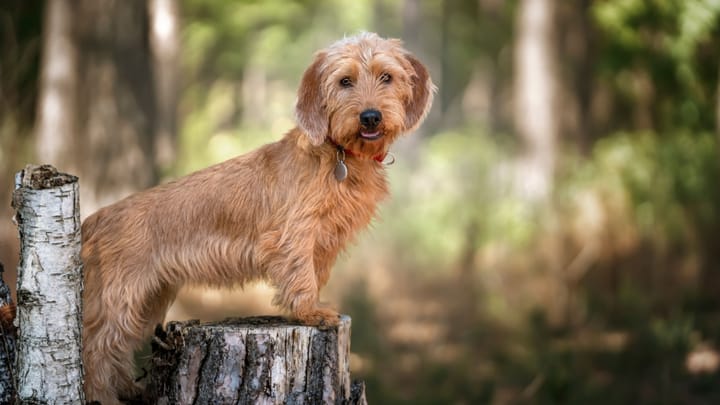Basset Fauve de Bretagne
Other name: Fawn Brittany Basset


The Basset Fauve de Bretagne is more commonly seen in France than elsewhere in the world. The breed is thought to have originated in Brittany, France’s north-westernmost region (hence its name). The breed was introduced into the UK in 1983 and was registered as a rare breed in 2007.
|
Life expectancy |
The Basset Fauve de Bretagne has a life expectancy of between 13 and 15 years |
|
Temperament |
|
|
Size |
Small
|
|
Adult size |
Female
Between 13 and 15 in
Male
Between 13 and 15 in
|
|
Adult weight |
Female
Between 31 and 35 lb
Male
Between 31 and 35 lb
|
|
Coat colour
These dogs are usually seen of fawn or wheaten colours and sometimes of ‘red brick’. |
Red |
|
Type of coat
Rough, short and wiry. |
Short Hard |
|
Eye colour
Dark brown |
Brown
|
|
Purchase price |
The Basset Fauve de Bretagne costs between £400 and £1 |
A hound such as the Bretagne is unlikely to be obedient all of the time. Bretagnes are independent dogs that require a firm (but fair) and consistent training regime. An owner that affords a dog of this breed too much behavioural leeway will eventually be challenged by the Bretagne for Top Dog position.
More details about the Basset Fauve de Bretagne
Basset Fauve de Bretagne: Origins and history
The breed is thought to have arisen from various crosses with the extinct Grand Fauve de Bretagne. Originally bred in Brittany, France, the dog’s skills of hunting were put to use first by the gentry of the Revolution and later by the commoners. The breed was brought to the UK in the 1980s. Its popularity, although risen since then, remains relatively unexceptional.
Physical characteristics of the Basset Fauve de Bretagne
A short-legged dog and long in the body; the head of the Bretagne is domed, longish and well-proportioned. The Bretagne’s ears are quite long, end in a point and turn inwards towards the cheek. When active the dog’s thick tail is carried up and over its top line.
FCI classification of the Basset Fauve de Bretagne
-
Group 6 - Scent hounds and related breeds
-
Section 1 : Scent hounds
Basset Fauve de Bretagne: Characteristics
Basset Fauve de Bretagne: Behaviour
Training a Basset Fauve de Bretagne
To train the Basset Bretagne requires the owner to deliver consistent and confident training. This is a dog that is easily distracted and quick to boredom.
Basset Fauve de Bretagne: Lifestyle
Breed compatibility Basset Fauve de Bretagne
Basset Fauve de Bretagne: Purchase price
A purebred puppy can cost you anywhere between £400 and £1,000 to buy. Cost of care will be £120 to £150 per month.
Basset Fauve de Bretagne: Shedding
Average
The Bretagne sheds only a small amount of hair throughout the year.
Basset Fauve de Bretagne: Grooming
Brush once or twice a week to prevent the coat from becoming tangled and matted. Hand-stripping of the coat at least twice a year is required of the Bretagne.
Basset Fauve de Bretagne: Health
A healthy breed of dog with no known genetic abnormalities or proneness to disease, it's life expectancy is 11 to 14 years.
This is an active and courageous dog that likes nothing better than a day of outdoor exploration.
The Bretagne is not very tolerant of hot temperatures. Special care must be taken of the Basset Bretagne during the summer months.
The Bretagne is tolerant of cold temperatures and wet weather.
The Basset Bretagne is prone to weight gain. If your dog is not exercised as regularly as it should be and is fed too much human or substandard food it will quickly become obese.
- Corneal ulcers and cataracts
- Ear infections
- Heart and kidney problems
- Hip Dysplasia
- Reproductive problems
Do you want a Basset Fauve de Bretagne dog ?
Oh no...
There are no Basset Fauve de Bretagne adoption profiles at the moment...




